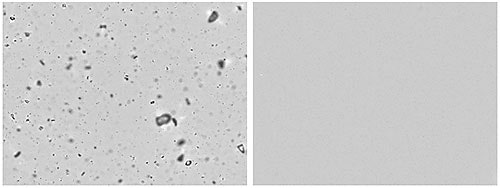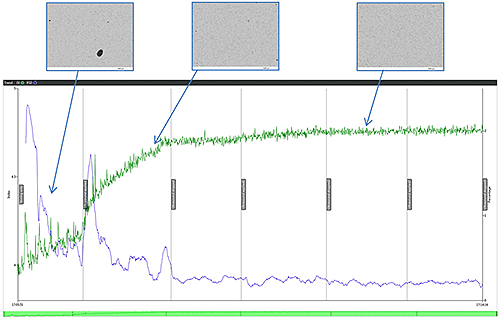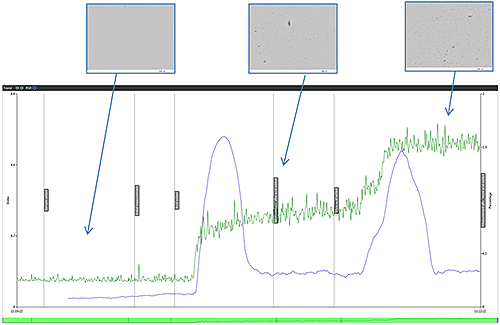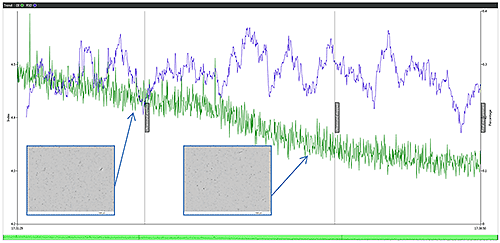The Dispersion Index and Dispersion Index RSD parameters measured by the Hydro Sight lensless imaging accessory enable users to monitor changes in the dispersion state of their samples during particle size measurements using the the Mastersizer 3000 laser diffraction system. Hydro Sight therefore provides a valuable tool to assist a laser diffraction user in optimizing the measurement reproducibility they obtain with a specific method.
The Hydro Sight is an imaging accessory which can be fitted in-line between a Mastersizer laser diffraction instrument and a wet dispersion unit. It provides a window on the sample dispersion, allowing the capture of images and videos of the sample as it is circulates through the Mastersizer system. In addition to the generation of real-time size and shape analysis, the dispersion status of the sample can be followed using the Dispersion Index parameters.
The Dispersion Index (DI) is a measure of the entropy, or disorder, in each image frame captured by the Hydro Sight system. It is calculated by assessing the variation in the measured intensity across each of the pixels in the image frame. The result of this calculation is displayed as the DI value in the software. The more non-uniform the frame is, the higher the DI value, and vice versa as demonstrated in Figure 1.

|
Calculated from this is the Relative Standard Deviation (RSD) of the DI. This is determined over a series of frames and is a measure of the variability of the disorder over a rolling frame set. A series of frames such as those presented in Figure 2 would consequently return a higher RSD value than those depicted in Figure 3 as there is greater variability in the uniformity of the frames.

|

|
The DI monitors changes in the dispersion state of the sample, whilst the RSD is an indication of the homogeneity of the sample. These parameters can be used in conjunction with the laser diffraction obscuration and Dv90 values generated by the Mastersizer to identify whether the sample is changing during measurements.
As a sample disperses it is undergoing a transition from a coarse particle size to a finer particle size. As this occurs, more particles will be seen within the image frames captured by the Hydro Sight system. This represents an increase in the disorder within each frame as there is a greater intensity variation across the image. As a consequence the DI value would be expected to increase. The reported RSD for the DI value would also increase as the sample disperses. At the same time, a reduction in the Dv90, coupled with an increase in the laser obscuration, would be seen with the Mastersizer. Once the process is complete the DI will remain at the higher level i.e. the frame remains non-uniform as there are many finer particles present. However, the RSD will decrease, indicating that the sample has reached a stable state of dispersion where there are no longer any changes in the number of particles observed in each image frame.
An example of a dispersion process is shown in Figure 4. This illustrates a typical DI and RSD profile during sonication of a sample to achieve full dispersion. Initially there is an increase in the DI, accompanied by a reduction in RSD, as the sample is partially dispersed from stirring alone. A sharp increase in DI is observed following the application of ultrasound, which is reflected in an initial increase in the RSD, before it drops off rapidly as the sample becomes more homogenised. A second, smaller increase is observed in the DI on application of the second burst of ultrasound, indicating that full dispersion is nearing completion. Following the third application of ultrasound, no changes are observed in the DI and the RSD remains at a low level, indicating that there has been no further change in the dispersion state of the sample and that it is fully dispersed. The captured images demonstrate this process, where agglomerated particles can be observed early in the measurement, but become increasingly infrequent as the sample disperses.

|
The behavior of the DI is a little more complex during an agglomeration process. In all cases, the RSD reported for the DI value will increase during agglomeration and will stabilize at a level higher than its initial state as a result of the increase in non-uniformity between frames caused by the presence of agglomerates. However, the nature of the change in the DI value (either increasing or decreasing) depends on the particle size of the fully dispersed sample. If agglomeration occurs in the situation where the particle size is large (typically >25 micron), the DI value reported by Hydro Sight will decrease. This decrease is caused by the fact that agglomeration of the particles reduces the number of particles in each frame. However, if the particle size is very small (typically < 10 microns), such that a significant proportion of the size distribution is below the measurement limit for the Hydro Sight system, agglomeration of the sample may cause the DI value to increase. This is because the agglomeration process causes particles to be formed which can be resolved by the system, leading to an increase in disorder within the frame.
An example of the trend observed during the agglomeration of a sample containing small particles is given in Figure 5. The small size of the initial sample, and its low contrast, means that the material is only just visible to Hydro Sight at the start of the measurement. This leads to a low DI being reported, as the image frames are very uniform. Agglomeration of the sample was started by adding acid to the dispersant. A sudden increase in the DI is observed as the agglomeration process starts, and is indicated by an increase in the reported RSD. This is a result of an increase in disorder within the image frames due to the formation and presence of the agglomerates which can be resolved by the Hydro Sight camera. The RSD then reduces as the sample stabilizes, but it remains at a higher level than its initial state as the sample has become less homogeneous due to the presence of the agglomerates. The same effect is also observed following the addition of more acid, as the sample is caused to agglomerate further.

|
The process of dissolution is characterized by a decrease in the dispersion index as, over the course of the measurement, fewer particles will appear in each frame. If the dissolution is rapid and a state is reached where no sample is visible from frame-to-frame this naturally will also be accompanied by a reduction in the RSD. This can be observed in Figure 6, where a sample is partially dissolving.

|
Note that care needs to be taken when interpreting profiles such as the one shown in Figure 6, as a similar trend could be seen for a dispersion process where the sample particle size for the final, fully-dispersed state is below the measurement range for the Hydro Sight system. In such a situation, the DI value would start to decrease as dispersion occurs, as the image frames will become more uniform as the number of observable particles decreases. Therefore, it is important that any conclusions drawn from the DI and RSD trends are cross-checked against what is observed visually from the Hydro Sight images and also what is seen within the Mastersizer measurements. In the case of dissolution, the image frames would be expected to show fewer particles over time and the Mastersizer will report a decrease in sample obscuration. In contrast, if dispersion to a very fine particle size was observed, the Mastersizer obscuration would be expected to increase.
The Dispersion Index and Dispersion Index RSD measured by Hydro Sight allow a user to monitor changes in the dispersion state of their samples by detecting subtle changes in the disorder of sample image frames. As these parameters relate to changes in the image frame as a whole, they are capable of following processes beyond the sizing capabilities of the Hydro Sight unit. This is because as individual particles do not need to be isolated and measured. Hydro Sight therefore provides a valuable tool to assist a laser diffraction user in identifying any sample processes which may be occurring during their laser diffraction measurements.